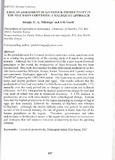An assessment of livestock productivity in the Nile basin countries: a malmquist approach

View/
Date
2011-09Author
Omiti, J.M.
Ndirangu, L.
Irungu, P.
Language
enMetadata
Show full item recordAbstract
As the global demand for livestock products continues to rise, questions arise
as to whether the productivity of the existing stock will match the growing
demand. Although the Nile basin countries hold the single largest livestock
population in the world, the productivity of these livestock has not been
documented. This study documented the state oflivestock productivity in five
Nile basin countries (Ethiopia, Kenya, Sudan, Tanzania and Uganda) using a
non-parametric Malmquist approach. Secondary data were obtained from
FAOSTAT spanning the 1985-2004 period. The focus was on cattle (beef and
dairy) and poultry products (meat and eggs). The results indicate that the
productivity of beef and veal in the five Nile basin countries increased by 1.5%
annually over the study period due to changes in innovation and technical
efficiency. At 5.1%, Ethiopia had the highest productivity change for beef and
veal most of which was due to increased efficiency. A 3.3% increase in
productivity of cow milk arose mainly from technological change. Kenyan
hens had the highest productivity in the region producing an average of 4kg of
eggs per hen annually followed by Tanzania (3.3kg/hen) and Ethiopia
(2.9kg/hen). Although the results indicate some real growth in particular
sectors of the livestock industry, the rate of growth is lower than that of the
human population in the region. Therefore, governments and other
stakeholders in the livestock sector in the region should invest in innovations
and strategies that will improve livestock productivity to meet the growing
demand.
Citation
Optimimization of Agricultural Value Chains for sustainable DevelopmentSponsorhip
National Council of Science and Technology, The Kenya Seed CompanyPublisher
Faculty of Agriculture, University of Nairobi
Description
aGRO 2011 Biennial Conference presentation
